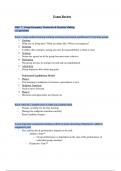Class notes
COMMERCE 1BA3 Full Exam Review (With Question Allocation)
- Course
- COMMERCE 1BA3
- Institution
- McMaster University (mcmasteru)
In class our teacher specifically outlined what topics will be on the exam along with how many questions each chapter or topic will be worth. Provided is complete notes for every topic from the slides and hints from the teacher. I used these to study and got an A.
[Show more]



